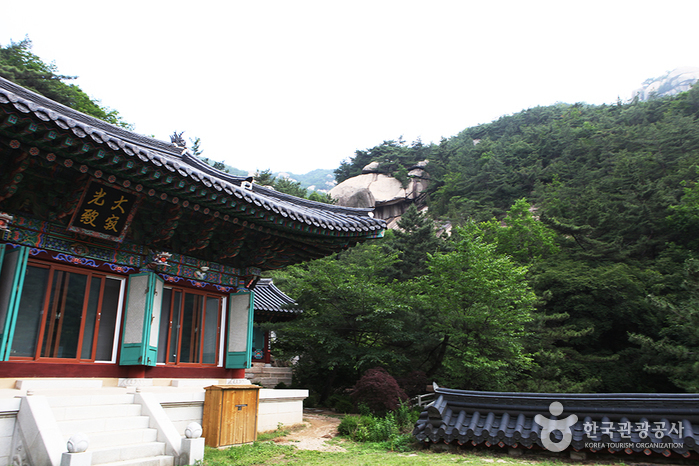Diame - Shinsegae Main Branch [Tax Refund Shop] (다이아미 신세계 본점)
7.0Km 2024-04-18
1F, 63, Sogong-ro, Jung-gu, Seoul
-
Berluti - Shinsegae Main Branch [Tax Refund Shop] (벨루티 신세계 본점)
7.0Km 2024-04-18
6F, 63, Sogong-ro, Jung-gu, Seoul
-
Omega - Shinsegae Main Branch [Tax Refund Shop] (오메가 신세계 본점)
7.0Km 2024-04-18
63, Sogong-ro, Jung-gu, Seoul
-
Dior - Shinsegae Main Branch (1F) [Tax Refund Shop] (디올 신세계 본점 1층)
7.0Km 2024-04-23
1F, 63, Sogong-ro, Jung-gu, Seoul
-
Fendi - Shinsegae Main Branch (2F) [Tax Refund Shop] (펜디 신세계 본점2층)
7.0Km 2024-04-19
63, Sogong-ro, Jung-gu, Seoul
-
Duko S.T.Dupont - Shinsegae Main Branch [Tax Refund Shop] (듀코 신세게(백)본점 듀퐁)
7.0Km 2024-04-16
6F Shinsegae Department Store Main Branch, 63, Sogong-ro, Jung-gu, Seoul
-
Seoul Geumseonsa Temple (금선사(서울))
7.0Km 2021-08-17
137, Bibong-gil, Jongno-gu, Seoul
+82-2-395-9911
Geumseonsa Temple is located within Bukhansan National Park, just behind Cheong Wa Da (The Blue House) and Gyeongbokgung Palace. The entrance to the temple is just off the hiking path to Bibong Peak.
After passing Banyajeon Hall, where Buddhist services are held, visitors will see a pine tree over 200 years old, and beyond that, a staircase with 108 steps leading up to Daejeokgwangjeon Hall in the temple's main area. To the right is Samseonggak House and Hongyegyo Bridge over the clear waters flowing down from the mountain.
Additional temple buildings include Mitajeon Hall and Yeonhwadang Hall, built in 2004 by Monk Beopan; and Jeokmukdang Hall, built using traditional construction techniques.
Olive Young - City Hall Station Branch [Tax Refund Shop] (올리브영 시청역)
7.0Km 2024-04-22
1, Sejong-daero 16-gil, Jung-gu, Seoul
-
Shinsegae Department Store - Main Store (신세계백화점 (본점))
7.0Km 2025-04-07
63 Sogong-ro, Jung-gu, Seoul
+82-1588-1234
Shinsegae Department Store opened its doors as the first modern department store in the country in 1960. It stands where Korea's first department store, the Japanese Misreukkosi Department Store, used to be in the 1930s. After undergoing remodeling in 2007, it reopened as a luxury hall, featuring diverse brands ranging from the top three international luxury brands to new designer brands. In addition, the Trinity Gardens and art halls in the department store serve as a cultural space for a shopping experience that combines art and shopping.
Daewoo Motel [Korea Quality]대우모텔[한국관광 품질인증]
7.0Km 2023-05-23
22-2, Sejong-daero 14-gil, Jung-gu, Seoul
+82-2-755-8067
Located in Bukchang-dong, Jung-gu, Seoul, the Daewoo Motel is 10 minutes’ walk from city sights such as Seoul Plaza, Deoksugung Palace and the Myeongdong shopping district. There are also many restaurants within a few minutes’ walk. The motel was remodelled and renovated in 2013, and rooms are equipped with all the usual amenities. A free breakfast plus luggage storage, laundry, and fax/photocopying services are provided.
![Diame - Shinsegae Main Branch [Tax Refund Shop] (다이아미 신세계 본점)](http://tong.visitkorea.or.kr/cms/resource/46/2890446_image2_1.jpg)
![Berluti - Shinsegae Main Branch [Tax Refund Shop] (벨루티 신세계 본점)](http://tong.visitkorea.or.kr/cms/resource/48/2890448_image2_1.jpg)
![Omega - Shinsegae Main Branch [Tax Refund Shop] (오메가 신세계 본점)](http://tong.visitkorea.or.kr/cms/resource/90/2890490_image2_1.jpg)
![Dior - Shinsegae Main Branch (1F) [Tax Refund Shop] (디올 신세계 본점 1층)](http://tong.visitkorea.or.kr/cms/resource/69/2890569_image2_1.jpg)
![Fendi - Shinsegae Main Branch (2F) [Tax Refund Shop] (펜디 신세계 본점2층)](http://tong.visitkorea.or.kr/cms/resource/85/2890585_image2_1.jpg)
![Duko S.T.Dupont - Shinsegae Main Branch [Tax Refund Shop] (듀코 신세게(백)본점 듀퐁)](http://tong.visitkorea.or.kr/cms/resource/10/2887810_image2_1.jpg)

![Olive Young - City Hall Station Branch [Tax Refund Shop] (올리브영 시청역)](http://tong.visitkorea.or.kr/cms/resource/77/2878577_image2_1.jpg)

![Daewoo Motel [Korea Quality]대우모텔[한국관광 품질인증]](http://tong.visitkorea.or.kr/cms/resource/80/2594580_image2_1.jpg)
 English
English
 한국어
한국어 日本語
日本語 中文(简体)
中文(简体) Deutsch
Deutsch Français
Français Español
Español Русский
Русский